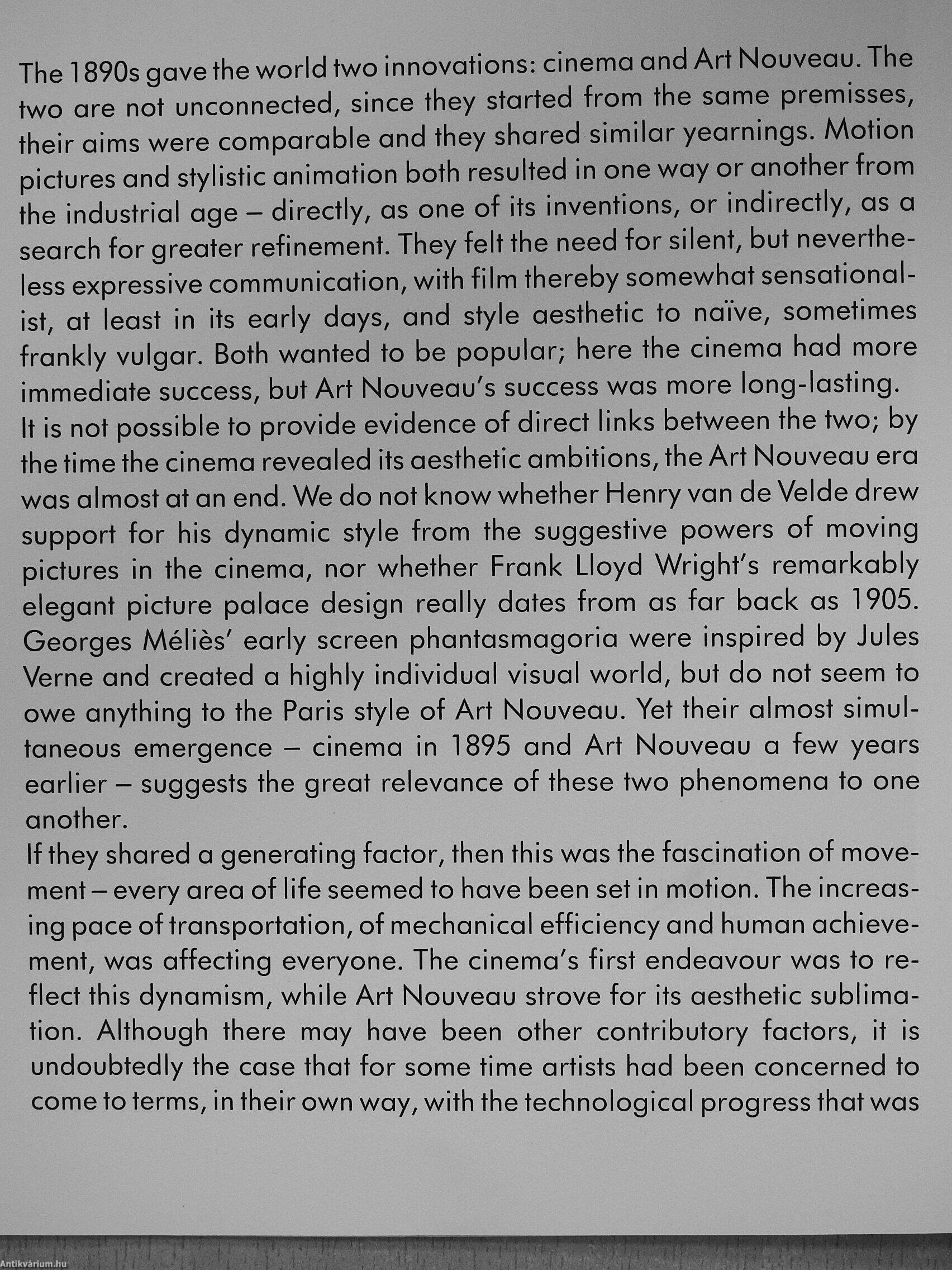1.035.018
kiadvánnyal nyújtjuk Magyarország legnagyobb antikvár könyv-kínálatát

VISSZA
A TETEJÉRE
JAVASLATOKÉszre-
vételek
Art Nouveau
Utopia: Reconciling the irreconcilable
| Kiadó: | Benedikt Taschen Verlag GmbH |
|---|---|
| Kiadás helye: | Köln |
| Kiadás éve: | |
| Kötés típusa: | Ragasztott papírkötés |
| Oldalszám: | 240 oldal |
| Sorozatcím: | |
| Kötetszám: | |
| Nyelv: | Angol |
| Méret: | 30 cm x 24 cm |
| ISBN: | 3-8228-0548-3 |
| Megjegyzés: | Színes és fekete-fehér fotókkal illusztrálva. |
naponta értesítjük a beérkező friss
kiadványokról
naponta értesítjük a beérkező friss
kiadványokról
Előszó
TovábbFülszöveg
Art nouveau, whose emergence at the same time as cinema was no mere coincidence, represents the most remarkable attempt to reconcile the demands of the technical age with the undying wish for beauty and glorification - or to pit the one against the other. Under the title "Art Nouveau - Utopia: Reconciling the Irreconcilable" the reform movement of the turn of the century is not only dealt with as an artistic event, but those economic and political interests which inspired, supported and handicapped it are also taken into account. In the chapters "Movement", "Unrest" and "Equilibrium" the historical phenomenon as a whole is characterised and is also presented with its own distinct local features. The centres of Brussels, Nancy, Barcelona, Glasgow, Helsinki and Chicago are dealt with in subchapters as are Munich, Darmstadt and Weimar. Finally, Vienna, as that city in which the synthesis achieved its culmination, is described separately. The outstanding artists are dealt with in... Tovább
Fülszöveg
Art nouveau, whose emergence at the same time as cinema was no mere coincidence, represents the most remarkable attempt to reconcile the demands of the technical age with the undying wish for beauty and glorification - or to pit the one against the other. Under the title "Art Nouveau - Utopia: Reconciling the Irreconcilable" the reform movement of the turn of the century is not only dealt with as an artistic event, but those economic and political interests which inspired, supported and handicapped it are also taken into account. In the chapters "Movement", "Unrest" and "Equilibrium" the historical phenomenon as a whole is characterised and is also presented with its own distinct local features. The centres of Brussels, Nancy, Barcelona, Glasgow, Helsinki and Chicago are dealt with in subchapters as are Munich, Darmstadt and Weimar. Finally, Vienna, as that city in which the synthesis achieved its culmination, is described separately. The outstanding artists are dealt with in detail in connection with the respective cities of their greatest activity. The result is a complex picture of the symbiosis of architecture, furniture design and craftsmanship with their corresponding approaches to artistic revitalisation.
Klaus-Jürgen Sembach, born in Magdeburg in 1933, studied architecture in Stuttgart. During his studies there he drew up the inventory of Henry van de Velde's estate. From 1961 to 1980 he worked at the museum "Die Neue Sammlung" in Munich. Since 1980 he has been director of the "Centrum Industriekultur" in Nuremberg. Among others he organised the exhibitions "Die Nützlichen Künste" (Useful Arts), 1981 in Berlin, "Zug der Zeit — Zeit der Züge" (The Railway Era), 1985 in Nuremberg, "So viel Anfang war nie - Deutsche Städte 1945-1949" (Never have there been so many beginnings - German cities 1945-1949), in Nuremberg and Berlin 1989. Numerous publications on architecture, design, photography and the film. Vissza
Témakörök
- Idegennyelv > Idegennyelvű könyvek > Angol > Művészetek > Építészet
- Idegennyelv > Idegennyelvű könyvek > Angol > Művészetek > Iparművészet
- Idegennyelv > Idegennyelvű könyvek > Angol > Művészetek > Művészettörténet, általános
- Idegennyelv > Idegennyelvű könyvek > Angol > Művelődéstörténet
- Művelődéstörténet > Civilizációtörténet > Egyéb
- Művelődéstörténet > Kultúra > Története
- Művészetek > Művészettörténet általános > Társadalom és művészet > Egyéb
- Művészetek > Művészettörténet általános > Idegen nyelv > Angol
- Művészetek > Művészettörténet általános > Művészettörténet > Külföldi
- Művészetek > Művészettörténet általános > Korszakok, stílusok > XX. század > Egyéb
- Művészetek > Építészet > Korszakok, stílusok > XX. század > Szecesszió
- Művészetek > Építészet > Idegen nyelv > Angol
- Művészetek > Építészet > Lakberendezés > Bútorok
- Művészetek > Iparművészet > Formatervezés > Design
- Művészetek > Iparművészet > Idegen nyelv > Angol
- Művészetek > Iparművészet > Bútor, lakberendezés > Stílusa
Klaus-Jürgen Sembach
Klaus-Jürgen Sembach műveinek az Antikvarium.hu-n kapható vagy előjegyezhető listáját itt tekintheti meg: Klaus-Jürgen Sembach könyvek, művekMegvásárolható példányok
Nincs megvásárolható példány
A könyv összes megrendelhető példánya elfogyott. Ha kívánja, előjegyezheti a könyvet, és amint a könyv egy újabb példánya elérhető lesz, értesítjük.









